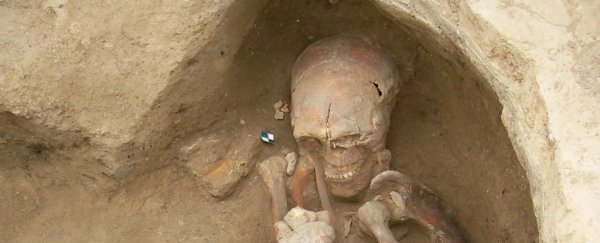An international team of archaeologists has recently discovered forensic evidence that suggests a series of 14 headless corpses found in Çatalhöyük, Turkey – once an ancient Neolithic city that thrived back in 7500 BC – might have been stripped of their flesh by vultures, before getting wrapped in cloth, folded into the foetal position and buried beneath a family's home.
The site – which lies 300 kilometres (186 miles) from modern day Ankara, Turkey – has fascinated archaeologists for decades, though researchers have often wondered why the site was covered in griffon vulture symbols. Now, thanks to the new analysis, they might have uncovered the gruesome truth.
Before we dive into the new study, we must first understand a little bit about Çatalhöyük. Çatalhöyük arose in 7500 BC, and was home to upwards of 10,000 people. Many of these citizens lived in underground homes that they accessed through the roof. In turn, these roofs acted as the city's streets.
When someone died in Çatalhöyük, they were often buried inside the family's home, usually under the floor. Most of the time, the corpses archaeologists found in these locations were wrapped up in the foetal position with some showing signs of defleshing – the removal of organs or skin before burial – in the form of knife marks.
The 14 headless skeletons, though, were different. The lack of heads wasn't that surprising to the scientists, what they were interested in was the fact that the skeletons didn't show any of these tell-tale knife marks, yet they were still defleshed. So what the heck happened?
For that answer, the team – led by Marin Pilloud from the University of Nevada – turned their attention to another mystery: the griffon symbols at the site. Maybe, the team hypothesised, the two were connected.
With that in mind, they set out to see if griffon vultures could actually deflesh a body like the ones found inside Çatalhöyük, using forensic texts that detailed how these birds typically deflesh animal corpses.
They found that vultures usually peck away most of a corpse's flesh, but leave behind the tendons and ligaments. This means that the skeletal remains are left fully intact after the birds are done feasting on their gory meals. Sometimes, the birds accidentally leave peck marks – which look like small V indents – but those seem few and far between.
Based on this, the team says that ancient Çatalhöyük citizens likely left their dead on the roofs of their houses (the city streets) where griffon vultures would easily find them, but other scavenging carnivores, such as stray dogs, wouldn't venture, because there were so many people around.
Once the birds had their fill, and the corpse was stripped of its flesh but still in one piece, families likely wrapped them in cloth and buried them under the floor.
It sounds unusual, but even today, defleshing isn't actually that uncommon, especially by vultures.
There's a Buddhist tradition in Tibet called 'sky burial', which involves a family dismembering their loved ones and leaving them on the slopes of mountains for birds and animals to feast on. A similar ritual is performed by the Parsi people of India.
It just goes to show that, even over thousands and thousands of years, we're not all that different from our ancestors.
The study didn't mention or investigate the lack of heads on the skeletons, so we'll have to wait for more research to fully understand that mystery.
The team's report was published in the Journal of Archaeological Science: Reports.
